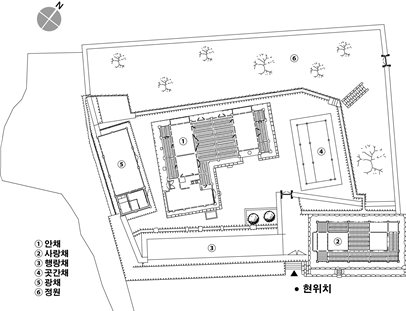청주 고은리 고택
- 청주 이항희 가옥(淸州 李恒熙 家屋)에서 청주 고은리 고택(淸州 高隱里 古宅)으로 지정명칭이 변경됨.(2017년 2월 23일 문화재청고시 제2017-32호)
| 청주 고은리 고택 Historic House of Goeun-ri, Cheongju |
|
 청주 고은리 고택, 국가문화유산포털, 문화재청. |
|
| 대표명칭 | 청주 고은리 고택 |
|---|---|
| 영문명칭 | Historic House of Goeun-ri, Cheongju |
| 한자 | 淸州 高隱里 古宅 |
| 주소 | 충청북도 청주시 상당구 남일면 고은리 190-1번지 |
| 지정(등록) 종목 | 국가민속문화재 제133호 |
| 지정(등록)일 | 1984년 1월 14일 |
| 분류 | 유적건조물/주거생활/주거건축/가옥 |
| 시대 | 조선시대 |
| 수량/면적 | 1필지/5,497㎡ |
| 웹사이트 | 청주 고은리 고택, 국가문화유산포털, 문화재청. |
해설문
국문
청주 고은리 고택은 철종 12년(1861)에 지은 안채와 그 이후에 지은 사랑채로 이루어진 가옥이다. 이 고택은 ‘고선재(高宣齋)’라고도 하는데, 이는 풍천도호부사(豊川都護府使)를 지냈던 이시득(李時得)이 내려와 살면서 학문과 덕을 베풀어 형편이 어려운 사람들을 도와준 것에서 유래한다.
이곳에서는 조선 후기에 특징적으로 나타나는 넓은 기둥 간격과 높은 지붕을 통해 전통적 건축 기법을 엿볼 수 있다. 고택은 ‘ㄱ’자형 안채와 ‘ㅡ’자형 행랑채 및 곳간채, 광채가 남아 있는데, 이는 전형적인 중부지방의 주거 형태이다. 또한 지형을 이용하여 담장을 쌓고, 내부에 채와 마당을 구분하는 담장을 쌓아 다양한 공간으로 조성한 것이 특징이다.
사랑채는 손님을 맞이하는 공간이므로 외부에 개방되어 있으며, 사랑채 앞에는 넓은 바깥마당이 있다. 지형상 동쪽으로 높은 곳에 있기 때문에 행랑채에 비하여 당당하게 드러나고 있는 모습이다.
사랑채 동쪽에는 수령이 300∼400년이 되는 회나무가 있고, 안마당 화단에는 모과나무, 향나무, 감나무 등이 있어 아담한 마당과 어우러진 전통적인 정원의 모습을 볼 수 있다.
영문
Historic House of Goeun-ri, Cheongju
This historic house is an example of the upper class residential architecture of the Cheongju area during the Joseon period (1392-1910). The house is known by the name Goseonjae, meaning “House of High Benevolence.” This name comes from the military official Yi Si-deuk (1574-1640), who lived in the house and was known for having shared his knowledge and virtue to help people in need.
It is unknown when this house was first established. The current buildings date to 1861 and later, with the oldest among them being the women’s quarters. There is also a men’s quarters, servants’ quarters, and two storehouses. The buildings’ shapes and overall layout are typical for the central region of the Korean Peninsula, and their architectural features, such as the wide spaces between pillars and the tall roofs, are typical for the late Joseon period.
The men’s quarters, located at the front right, served as a reception area for guests. It was therefore made directly accessible from its wide front yard. Its tiled hip-and-gable roof and tall stone foundation distinguish it from the thatched roof servants’ quarters to the left. Behind the men’s quarters, there is an enclosure wall that blocks the view into the inner courtyard and women’s quarters in accordance with the Confucian principle of separation of the sexes. The storehouses are located next to the women’s quarters.
The house displays the features of a traditional Korean garden, as seen in the 300 to 400-year-old Siberian spindletree next to the men’s quarters and the quince, Chinese juniper, and persimmon trees in the inner courtyard.
영문 해설 내용
이 고택은 조선시대 청주 지역의 지주계층이 살던 집이다. ‘고선재’라고도 부르는데, 조선 후기의 무신인 이시득(1574-1640)이 이 곳에 살면서 학문과 덕을 베풀어 형편이 어려운 사람들을 도와준 것에서 유래한다.
언제 처음 지어졌는지는 알 수 없고, 현재의 집은 1861년에 지은 안채와 그 이후에 지은 사랑채, 행랑채, 곳간채로 이루어져 있다. 건물의 형태와 전체적인 구조는 한반도 중부 지방 가옥의 전형적인 모습을 보여준다. 또한 기둥 간격을 넓게 두고 지붕을 높게 올리는 등 조선 후기에 특징적으로 나타나는 건축 양식도 엿볼 수 있다.
앞쪽 오른편에 있는 사랑채는 손님을 맞이하는 공간이므로, 외부에 개방되어 있고 앞에는 넓은 바깥마당이 있다. 돌로 쌓은 기단 위에 높은 팔작지붕 건물로 세워, 왼쪽의 행랑채에 비하여 당당한 위계를 드러냈다. 사랑채 뒤에는 담장을 쌓아 안마당과 안채가 보이지 않도록 했는데, 이는 유교의 남녀유별 사상에 따른 것이다. 곳간채는 안채 옆에 있다.
사랑채 옆에는 수령이 300-400년이 되는 회나무가 있고, 안마당 화단에는 모과나무, 향나무, 감나무 등이 있어 한국 전통 정원의 모습을 볼 수 있다.
갤러리
고은리 고택 배치도[1]
참고자료
- 이시득, 한국역대인물종합정보시스템, 한국학중앙연구원. http://people.aks.ac.kr/front/dirSer/ppl/pplView.aks?pplId=PPL_6JOb_A9999_1_0018721&curSetPos=0&curSPos=0&category=dirSer&isEQ=true&kristalSearchArea=P
주석
- ↑ 『2022년도 청주시 지정문화재 안내판 문안정비 연구』, 충청북도문화재연구원, 2022, 17쪽.
